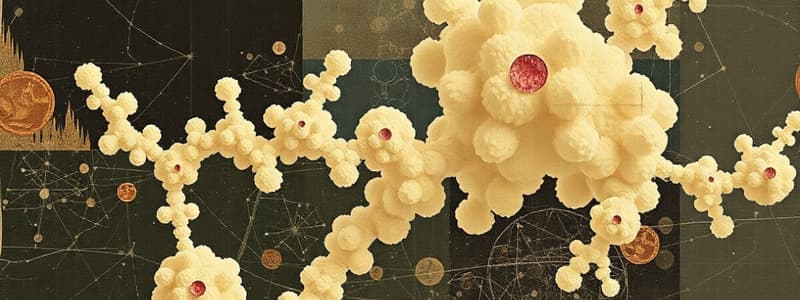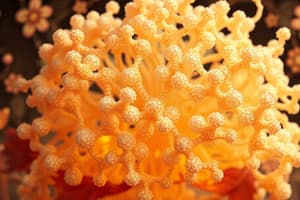Podcast
Questions and Answers
What is the minimum number of monosaccharide units required to classify a carbohydrate as a polysaccharide?
What is the minimum number of monosaccharide units required to classify a carbohydrate as a polysaccharide?
- 10 (correct)
- 15
- 5
- 20
Which of the following substances is classified as a structural polysaccharide?
Which of the following substances is classified as a structural polysaccharide?
- Inulin
- Cellulose (correct)
- Starch
- Glycogen
What type of glycosidic bonds link glucose units in amylose?
What type of glycosidic bonds link glucose units in amylose?
- α 1-6 glycosidic bonds
- β 1-6 glycosidic bonds
- β 1-4 glycosidic bonds
- α 1-4 glycosidic bonds (correct)
Which polysaccharide is characterized by branched structures forming α 1-6 glycosidic bonds?
Which polysaccharide is characterized by branched structures forming α 1-6 glycosidic bonds?
Which polysaccharide reacts with iodine to produce a blue color?
Which polysaccharide reacts with iodine to produce a blue color?
What is the main function of storage polysaccharides like glycogen and starch?
What is the main function of storage polysaccharides like glycogen and starch?
Which of these is a correct example of a heteropolysaccharide?
Which of these is a correct example of a heteropolysaccharide?
Which component makes up the linear non-branching layer of starch?
Which component makes up the linear non-branching layer of starch?
What type of polysaccharides are inulin and dextran classified as?
What type of polysaccharides are inulin and dextran classified as?
What is the primary function of starch in plants?
What is the primary function of starch in plants?
What type of glucose units primarily make up dextran?
What type of glucose units primarily make up dextran?
How is glycogen structurally characterized compared to amylopectin?
How is glycogen structurally characterized compared to amylopectin?
What is the end product of starch hydrolysis by amylase enzymes?
What is the end product of starch hydrolysis by amylase enzymes?
Which characteristic distinguishes dextrins from starch?
Which characteristic distinguishes dextrins from starch?
Which of the following about α-dextrinase is true?
Which of the following about α-dextrinase is true?
What is a common medical use for dextran?
What is a common medical use for dextran?
Which bond type is most prevalent in dextran's structure?
Which bond type is most prevalent in dextran's structure?
Which component is not an end product of amylase hydrolysis of starch?
Which component is not an end product of amylase hydrolysis of starch?
What is the primary type of glycosidic linkage in amylose?
What is the primary type of glycosidic linkage in amylose?
What is the primary function of glycogen in the human body?
What is the primary function of glycogen in the human body?
Which statement about inulin is accurate?
Which statement about inulin is accurate?
Cellulose is primarily composed of which type of sugar units?
Cellulose is primarily composed of which type of sugar units?
What is the role of cellulose in the diet?
What is the role of cellulose in the diet?
What happens to glycogen during fasting?
What happens to glycogen during fasting?
Which statement is true regarding cellulose's resistance to hydrolysis?
Which statement is true regarding cellulose's resistance to hydrolysis?
Inulin is often used in medical tests for what purpose?
Inulin is often used in medical tests for what purpose?
Which of the following describes a primary characteristic of cellulose?
Which of the following describes a primary characteristic of cellulose?
Which enzyme is responsible for hydrolyzing inulin in plants?
Which enzyme is responsible for hydrolyzing inulin in plants?
Which statement about the presence of cellulose in human nutrition is correct?
Which statement about the presence of cellulose in human nutrition is correct?
Which glycosaminoglycan is primarily abundant in corneal tissue?
Which glycosaminoglycan is primarily abundant in corneal tissue?
What is the primary function of chondroitin sulfate in the human body?
What is the primary function of chondroitin sulfate in the human body?
Which of the following statements about dermatan sulfate is correct?
Which of the following statements about dermatan sulfate is correct?
Which amino-sugar is found in keratan sulfate?
Which amino-sugar is found in keratan sulfate?
What is the primary source of agarose used in gel chromatography?
What is the primary source of agarose used in gel chromatography?
Which sugar acid is found in chondroitin sulfate?
Which sugar acid is found in chondroitin sulfate?
Which of the following is a characteristic of glycosaminoglycans (GAGs)?
Which of the following is a characteristic of glycosaminoglycans (GAGs)?
Which amino sugar is commonly found in glycosaminoglycans?
Which amino sugar is commonly found in glycosaminoglycans?
What is the main function of heparin?
What is the main function of heparin?
Which glycosaminoglycan is known for being non-sulfated?
Which glycosaminoglycan is known for being non-sulfated?
Where are proteoglycans typically found in the body?
Where are proteoglycans typically found in the body?
What type of sugar is L-iduronic acid categorized as?
What type of sugar is L-iduronic acid categorized as?
Which of the following statements is true about the amino group in amino sugars in GAGs?
Which of the following statements is true about the amino group in amino sugars in GAGs?
What function does hyaluronic acid serve in the body?
What function does hyaluronic acid serve in the body?
Heparan sulfate is primarily associated with which types of cell surfaces?
Heparan sulfate is primarily associated with which types of cell surfaces?
What distinguishes the structural composition of heparin from that of glucosamine?
What distinguishes the structural composition of heparin from that of glucosamine?
Flashcards
Polysaccharide Definition
Polysaccharide Definition
A polymer composed of more than 10 monosaccharides linked by glycosidic bonds.
Homopolysaccharide
Homopolysaccharide
A polysaccharide containing only one type of monosaccharide.
Heteropolysaccharide
Heteropolysaccharide
A polysaccharide containing more than one type of monosaccharide.
Starch Structure
Starch Structure
Signup and view all the flashcards
Amylose
Amylose
Signup and view all the flashcards
Amylopectin
Amylopectin
Signup and view all the flashcards
Glycosidic Bond
Glycosidic Bond
Signup and view all the flashcards
Starch Function
Starch Function
Signup and view all the flashcards
Storage Polysaccharides
Storage Polysaccharides
Signup and view all the flashcards
Starch
Starch
Signup and view all the flashcards
α-Dextrin
α-Dextrin
Signup and view all the flashcards
Dextran
Dextran
Signup and view all the flashcards
Glycogen
Glycogen
Signup and view all the flashcards
Hydrolysis of Starch
Hydrolysis of Starch
Signup and view all the flashcards
α-glucose
α-glucose
Signup and view all the flashcards
Glycogen Function
Glycogen Function
Signup and view all the flashcards
Glycogen Breakdown
Glycogen Breakdown
Signup and view all the flashcards
Inulin Structure
Inulin Structure
Signup and view all the flashcards
Inulinase
Inulinase
Signup and view all the flashcards
Inulin Clearance Test
Inulin Clearance Test
Signup and view all the flashcards
Cellulose Structure
Cellulose Structure
Signup and view all the flashcards
Cellulose Function
Cellulose Function
Signup and view all the flashcards
Cellulose Digestion
Cellulose Digestion
Signup and view all the flashcards
Ruminant Animals
Ruminant Animals
Signup and view all the flashcards
What is the primary function of Keratan Sulfate?
What is the primary function of Keratan Sulfate?
Signup and view all the flashcards
What makes Chondroitin Sulfate important for cartilage?
What makes Chondroitin Sulfate important for cartilage?
Signup and view all the flashcards
What function does Dermatan Sulfate serve in the body?
What function does Dermatan Sulfate serve in the body?
Signup and view all the flashcards
What is the unique characteristic of Keratan Sulfate among GAGs?
What is the unique characteristic of Keratan Sulfate among GAGs?
Signup and view all the flashcards
What is the primary sugar acid present in Chondroitin Sulfate?
What is the primary sugar acid present in Chondroitin Sulfate?
Signup and view all the flashcards
What kind of amino sugar is found in Dermatan Sulfate?
What kind of amino sugar is found in Dermatan Sulfate?
Signup and view all the flashcards
Glycosaminoglycans (GAGs)
Glycosaminoglycans (GAGs)
Signup and view all the flashcards
Disaccharide unit in GAGs
Disaccharide unit in GAGs
Signup and view all the flashcards
Amino sugar in GAGs
Amino sugar in GAGs
Signup and view all the flashcards
Sugar acid in GAGs
Sugar acid in GAGs
Signup and view all the flashcards
Proteoglycans
Proteoglycans
Signup and view all the flashcards
Hyaluronic acid
Hyaluronic acid
Signup and view all the flashcards
Heparin function
Heparin function
Signup and view all the flashcards
Proteoglycan function
Proteoglycan function
Signup and view all the flashcards
GAG location in body
GAG location in body
Signup and view all the flashcards
Sulfation of GAGs
Sulfation of GAGs
Signup and view all the flashcards
Study Notes
Polysaccharides
- Polysaccharides, also known as glycans, are composed of more than 10 monosaccharide units or their derivatives joined by glycosidic linkages.
Types of Polysaccharides
- Homopolysaccharides (homoglycans): Contain only one type of monosaccharide. Examples include starch, glycogen, dextran, dextrin, cellulose, and inulin.
- Heteropolysaccharides (heteroglycans): Contain more than one type of monosaccharide. Examples include glycosaminoglycans (GAGs), such as mucopolysaccharides, and agar.
Classification of Polysaccharides
- Storage polysaccharides: Used for energy storage. Examples include starch (plants), glycogen (animals), dextran, and inulin.
- Structural polysaccharides: Provide structural support. Examples include cellulose (plants), agar.
Homopolysaccharides (Detailed)
-
1. Starch:
- Structure: Composed of two layers:
- Amylose: Linear, non-branching, glucose units linked by α-1,4 glycosidic bonds. Iodine reacts with amylose to produce a blue color.
- Amylopectin: Highly branched, glucose units linked by α-1,4 and α-1,6 glycosidic bonds. Iodine reacts with amylopectin to yield a red-violet color.
- Function: The primary storage polysaccharide in plants.
- Hydrolysis: Amylase enzymes (salivary and pancreatic) rapidly hydrolyze both amylose and amylopectin to yield maltose and dextrins.
- Structure: Composed of two layers:
-
2. α-Dextrin:
- Structure: Results from the partial hydrolysis of starch by acids or enzymes. Consists of several glucose units. Hydrolyzed by α-dextrinase.
- Function: Used as mucilage.
-
3. Dextran:
- Structure: Highly branched α-glucose units. Primarily α-1,6 glycosidic bonds, with occasional α-1,4 bonds.
- Function: Storage polysaccharide produced by microorganisms (yeasts, bacteria). Used intravenously as a plasma volume expander to treat hypovolemic shock.
-
4. Glycogen (animal starch):
- Structure: Highly branched α-glucose units. Branches every 8-12 glucose units(higher branching than amylopectin). Iodine reacts with glycogen to give a red-violet color.
- Function: The primary storage polysaccharide in animals and humans. Found in the liver and skeletal muscles.
- In fasting states, glycogen is hydrolyzed to glucose to maintain blood glucose levels.
-
5. Inulin:
- Structure: Formed from fructose.
- Function: Found in plants. Hydrolyzed by inulinase. Used in inulin clearance tests to evaluate glomerular filtration rate. Potentially a dietary component for those with diabetes.
-
6. Cellulose:
- Structure: Composed of β-D-glucose units.
- Function: The primary structural component of plant cell walls. Extremely resistant to hydrolysis by acids and digestive enzymes. Can stimulate peristalsis and prevent constipation. Certain bacteria in the gut of ruminant animals can hydrolyze cellulose.
Heteropolysaccharides (Detailed)
-
Glycosaminoglycans (GAGs):
-
Structure: Long, linear, unbranched chains of repeating disaccharides. Disaccharides contain either N-acetyl-glucosamine or N-acetyl-galactosamine and either glucuronic or iduronic acid. Amino sugars are often acetylated or sulfated.
-
Proteoglycans: Most GAGs (except hyaluronic acid) are covalently linked to proteins to form proteoglycan monomers.
- Examples (with brief characteristics):
- 1-Heparin: Anticoagulant; found in mast cells.
- 2-Heparan sulfate: Component of cell surfaces; found in extracellular matrix.
- 3-Hyaluronic acid: Non-sulfated; found in synovial fluid, connective tissue, lubricating joints, etc.
- 4- Keratan sulfate: Found in cornea; contributes to corneal transparency.
- 5- Chondroitin sulfate: Found in cartilage; responsible for its elasticity and compressibility.
- 6- Dermatan sulfate: Found in skin, blood vessels; involved in blood coagulation, wound repair, etc.
- Examples (with brief characteristics):
-
-
Agar:
- Structure: A polysaccharide isolated from marine red algae, composed of agarose and agaropectin.
- Function: Used as a gel in gel chromatography, gel electrophoresis, and in microbiological culture media preparation.
Studying That Suits You
Use AI to generate personalized quizzes and flashcards to suit your learning preferences.




